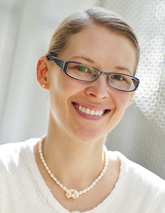Alexandra Boltasseva facts for kids
Quick facts for kids
Alexandra Boltasseva
|
|
|---|---|
 |
|
| Born | January 11, 1978 Kanash, Chuvash Autonomous Soviet Socialist Republic, Chuvashia
|
| Citizenship | United States |
| Alma mater | Moscow Institute of Physics and Technology, Russia |
| Awards |
|
| Scientific career | |
| Fields |
|
| Institutions | Purdue University, Technical University of Denmark |
Alexandra Boltasseva (born January 11, 1978) is a leading scientist. She is a distinguished professor at Purdue University. There, she teaches electrical and computer engineering. She also helps lead Optical Materials Express, a science journal.
Professor Boltasseva studies special materials called plasmonic metamaterials. These are human-made materials, often metals. They use tiny light waves called surface plasmons. This allows them to have amazing light properties not found in nature.
Contents
Becoming a Scientist
Alexandra Boltasseva started her science journey in Russia. She studied physics at the Moscow Institute of Physics and Technology. Her early work focused on quantum-well lasers. These are tiny lasers used in many technologies.
Later, she moved to Denmark for her PhD. She studied nanophotonics and nanofabrication at the Technical University of Denmark. Nanophotonics is about controlling light on a very tiny scale. Nanofabrication means making things that are super small.
After her PhD, she worked at some new companies. Then she returned to the Technical University of Denmark. In 2008, she joined Purdue University in the United States. She is now a top professor there.
What Her Research Is About
Professor Boltasseva's team works with light and tiny materials. They focus on nano- and quantum photonics. This means they study how light behaves in very small spaces. They also work with plasmonics, which is about how light interacts with metals.
Another key area is optical metamaterials. These are special materials designed to control light in new ways. They also do nanofabrication, which is making these tiny structures.
Her main goal is to find new ways to create and improve these tiny light structures. They use computers and machine learning to help design them. This research helps create new materials that can control light better. These materials can be used for many things.
They could lead to faster computer chips. They might help with handling information and storing data. Her work could also improve medical imaging and treatments. It might even help with quantum information technologies.
Awards and Honors
Professor Boltasseva has received many awards for her important research:
- In 2023, she became a Fellow of the American Physical Society. This was for her big impact on nanophotonics and metamaterials.
- She also won the R.W. Wood Prize in 2023.
- In 2021, she was named one of The Highly Cited Researchers™ by Clarivate™. This means her work is often used and referenced by other scientists.
- She became a Fellow of the Materials Research Society in 2021. This was for her work on plasmonic materials.
- In 2020, she was named a Fellow of the National Academy of Inventors (NAI).
- She became a Fellow of the Institute of Electrical and Electronics Engineers (IEEE) in 2019.
- In 2018, she was a finalist for the Blavatnik National Award for Young Scientists.
- She became a Fellow of The International Society For Optics And Photonic (SPIE) in 2017.
- In 2015, she became a Fellow of The Optical Society. This was for her important work in nanophotonics.
- She won the IEEE Photonics Society Young Investigator Award in 2013.
- Also in 2013, she received the Materials Research Society Outstanding Young Investigator Award.
- In 2011, MIT Technology Review named her a Top Young Innovator (TR35).
Leading a Science Journal
Since 2016, Professor Boltasseva has been the editor-in-chief for The Optical Society's Optical Materials Express journal. In this role, she helps decide which new research papers get published. This means she plays a big part in sharing new discoveries in optics and materials science with the world.

